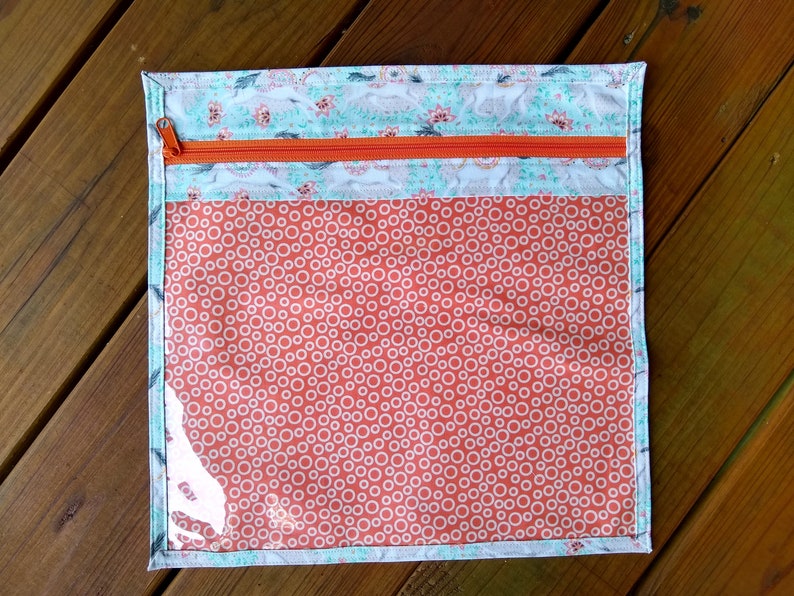Last year, I figured out how to make a project bag with a vinyl window and wrote up the instructions so I could teach the technique to my sewing friends. I always had trouble putting the last couple of steps in words.
This weekend, I made one and photographed the last few steps so I could show it to one of my Monday morning stitchers as she was wanting to make her own bags.
If you want the .pdf of the instructions, you need to leave me a message with your email address in the comments below.
The tricky part was what to do after the zipper was installed and the square piece was added to it. At this point, the lining (on the back of the printed fabric shown) is attached to all the pieces and topstitched. Unzip the zipper to at least halfway.
Now take the bottom edge (left edge as pictured above) of the printed fabric and fold it to match the raw edge on the right side with right sides together together. Do the same with the lining on the lining side.
Here, the fold is at the top and the clips are down the sides. If using pins make sure you do not pin through the vinyl. The clips by the zipper on the right are holding the open ends of the zipper together so they don't leave a gap when sewing. I had to use my walking foot to sew down the sides but have also done it without. If you use a 16" zipper (pictured), you don't have to worry about hitting the metal bits with your sewing machine needle. The just trim off the excess later. However, I have made this bag with a 14" zipper and just marked where the metal bits were to make sure I didn't sew there. You could also put fabric tabs on each end of your zipper to ensure you don't hit metal.
Mark a 5" opening on the bottom of the lining. I use an erasable pen from Staples. Frixion pens are good and made by PaperMate (as are the regular erasable pens) but a bit more expensive.
This is what the interfaced patterned fabric looks like on the flip side.
Sew 1/4" seam down the sides through all the layers stopping short of the bottom by 3/8" or so.
Fold the lining back, and sew all along the bottom of the patterned fabric.
I pinned the lining back so it wouldn't get caught.
Flip the bag over and folding back the printed fabric, sew the lining bottom from the corner to the 5" mark. - backstitching to reinforce it. Lift the presser foot and slide the lining back to the other 5" mark, backstitch and sew from there to the other corner. You're almost finished!
Put your hand through the 5"opening between the lining pieces and reach through the zipper to turn the piece right side out.
Don't worry if the vinyl gets crinkled a bit - it can be smoothed out with a warm iron from the back through the fabric.
Poke out all the corners carefully with a pointy yet blunt object (chopstick, pen with the nib retracted, closed blunt scissors). Sew up the 5"opening in the bottom of the lining either with a narrow seam or by hand.
My next iteration of the bag will but using a bigger piece of vinyl so a fat quarter (18" - 20") can be used instead of pieces of fabric 23" long. Basically my vinyl will be about 5" longer.
A lot of people are making the project bags with vinyl on the entire front below the zipper and using binding to hold the back and front together like this:
Here's a tutorial on how to do that.
My personal preference is the method that doesn't use binding but that's just me.
Where does one get vinyl? Bedding (sheets, duvets, ets.) comes in sturdy vinyl that can be cut to the right size. Our local fabric chain (Fabricland) sells it back in the all-weather fabric department. It's in long rolls (54"? 60"?)
I have heard cautionary tales about the vinyl turning fabric yellow after lengthy storage. I don't know if some vinyls are better than others so I suggest you not keep projects in the bags indefinitely.











No comments:
Post a Comment